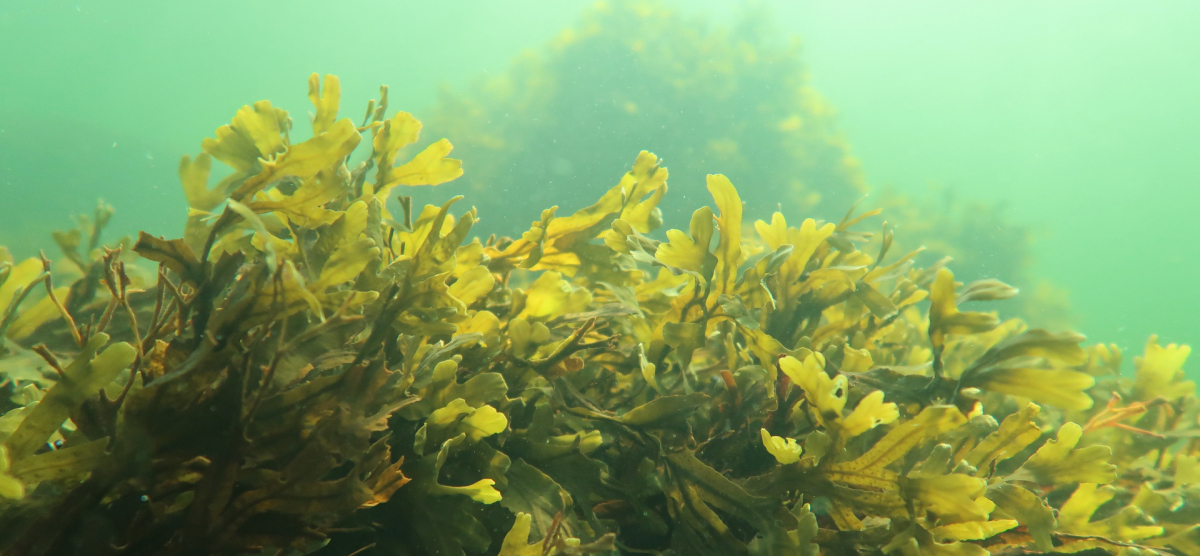- Press Office
- Press releases
- Slime for the climate, delivered by brown algae
Slime for the climate, delivered by brown algae
Brown algae are true wonder plants when it comes to absorbing carbon dioxide from the air. They even outcompete forests on land in this, and thus play a decisive role for the atmosphere and our climate. But what happens to the carbon dioxide after the algae have absorbed it? Researchers at the Max Planck Institute for Marine Microbiology now report in the Proceedings of the National Academy of Sciences (PNAS) that the brown algae can remove large amounts of carbon dioxide from the global cycle in the long term and thus can counteract global warming.
Fucoidan: Brown algae slime is not a favourite dish
Algae take up carbon dioxide from the atmosphere and use the carbon to grow. They release up to a third of the carbon they absorb back into the seawater, for example in the form of sugary excretions. Depending on the structure of these excretions, they are either quickly used by other organisms or sink towards the seafloor.
“The excretions of brown algae are very complex and therefore incredibly complicated to measure,” says first author Hagen Buck-Wiese from the Max Planck Institute for Marine Microbiology in Bremen. “However, we have managed to develop a method to analyse them in detail.” With this method, the researchers scrutinised a large number of different substances. The so-called fucoidan turned out to be particularly exciting. “Fucoidan made up about half of the excretions of the brown algae species we studied, the so-called bladderwrack,” says Buck-Wiese. Fucoidan is a recalcitrant molecule. “The fucoidan is so complex that it is very hard for other organisms to use it. No one seems to like it.” As a result, the carbon from the fucoidan does not return to the atmosphere quickly. “This makes the brown algae particularly good helpers in removing carbon dioxide from the atmosphere in the long term – for hundreds to thousands of years.”
Brown algae could bind almost all of Germany's carbon dioxide emissions
Brown algae are remarkably productive. It is estimated that they absorb about 1 gigaton (one billion tons) of carbon per year from the air. Using the results of the present study, this would mean that up to 0.15 gigatons of carbon, equivalent to 0.55 gigatons of carbon dioxide, are sequestered by brown algae each year in the long term. For comparison: Germany's annual greenhouse gas emissions currently amount to about 0.74 gigatons of carbon dioxide, according to the Federal Environment Agency (Umweltbundesamt, estimation for 2020).
“And even better: The fucoidan does not contain any nutrients such as nitrogen,” Buck-Wiese explains further. Thus, the growth of the brown algae is not affected by the carbon losses.
More species and sites
For the current study, Buck-Wiese and his colleagues from the MARUM MPG Bridge Group Marine Glycobiology, which is based at both the Bremen Max Planck Institute and MARUM - Centre for Marine and Environmental Sciences at the University of Bremen, conducted their experiments at the Tvärminne Zoological Station in southern Finland. “Next we want to look into other brown algae species and other locations,” says Buck-Wiese. “The great potential of brown algae for climate protection definitely needs to be further researched and utilised.”
Brown algae come in many different varieties: Kelp, which forms metre-high forests under the water surface, is one of them, as is rockweed, which is widespread for instance on Helgoland and has conspicuous gas bladders that are used for reproduction. Brown algae preferably live in temperate and cold marine regions and grow on solid substrates, for example rocks and stones. Brown algae are also used as food (kombu, wakame), to obtain gelling agents (alginates) and as a putative remedy. In total, there are between 1500 and 2000 species of brown algae worldwide.
The subject of the present study was the bladderwrack Fucus vesiculosus. It is widespread in the North and Baltic Seas and in the North Atlantic. Bladderwrack is a perennial plant and grows up to 30 centimetres long. It clings to rocks and other substrates with an adhesive plate. The bladderwrack gets its name from the distinctive spherical gas bubbles that provide buoyancy and are clearly visible in this picture.
Original publication
Hagen Buck-Wiese, Mona A. Andskog, Nguyen P. Nguyen, Margot Bligh, Eero Asmala, Silvia Vidal-Melgosa, Manuel Liebeke, Camilla Gustafsson, Jan-Hendrik Hehemann (2022): Fucoid brown algae inject fucoidan carbon into the ocean. PNAS (December 2022)
Participating institutions
- Max Planck Institute for Marine Microbiology, 28359 Bremen, Germany
- University of Bremen, Center for Marine Environmental Sciences, MARUM, 28359 Bremen, Germany
- Centre for Coastal Biogeochemistry, Southern Cross University, 2480 Lismore, Australia
- University of Helsinki, Tvärminne Zoological Station, 10900 Hanko, Finland
- Geological Survey of Finland, Environmental Solutions, 02151 Espoo, Finland
Contact
Group leader
MARUM MPG Bridge Group Marine Glycobiology
MPI for Marine Microbiology
Celsiusstr. 1
D-28359 Bremen
Germany
|
Room: |
2126 |
|
Phone: |

Head of Press & Communications
MPI for Marine Microbiology
Celsiusstr. 1
D-28359 Bremen
Germany
|
Room: |
1345 |
|
Phone: |



